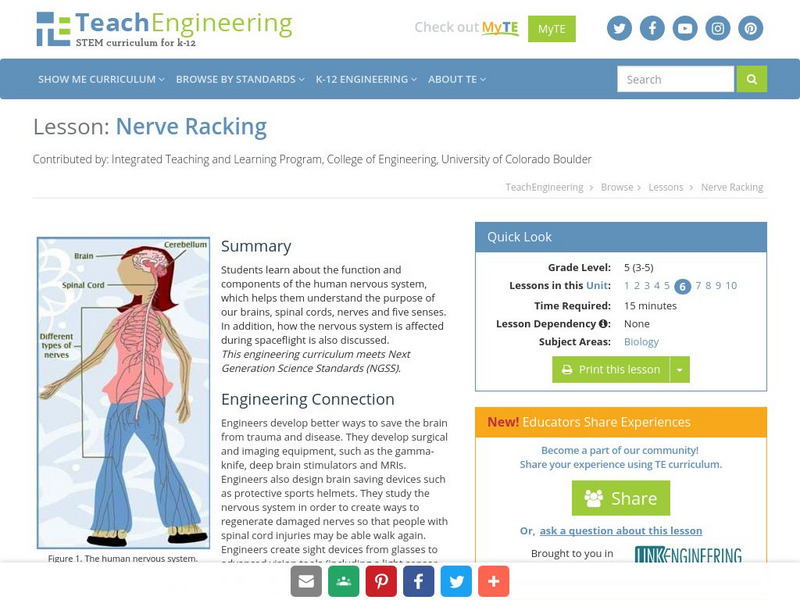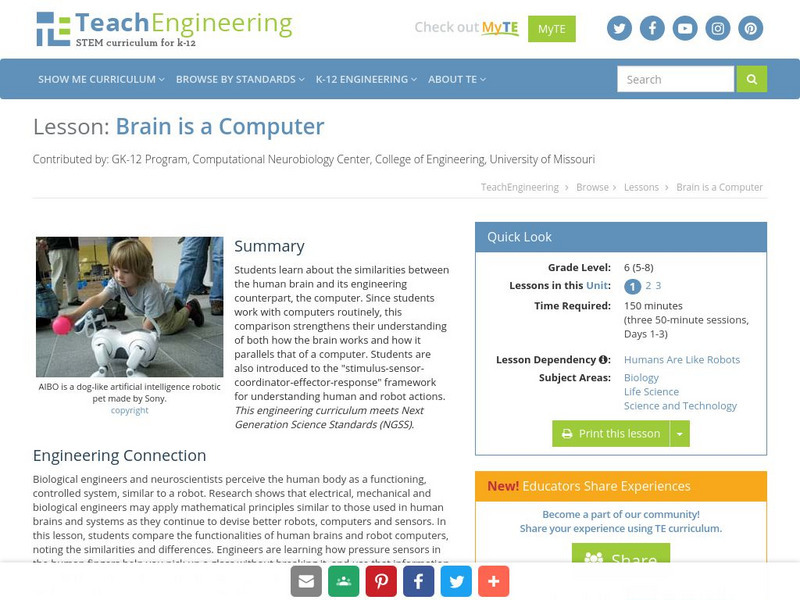Hi, what do you want to do?
Curated OER
Feelin' Hot, Hot Hot!
Students explore human anatomy by researching first aid care. In this heat related injury lesson, students discuss the problems extreme temperatures can cause on the human body if left untreated. Students define the different injuries,...
Curated OER
Left and Right Brains
Students research the part of the brain known as the corpus callosum. The part of the brain that connects the left and right brain, students investigate its functions and how data passes from one side to another.
Curated OER
Effects of Environment on Memory
Students explore the effect that environment has on memory. They analyze their own study habits and draw conclusions about their work behaviors. Baseline capacity is established for the subjects' ability to memorize an increasing series...
Curated OER
Anatomy
Fifth graders identify and describe the functions of the major body systems. They discover how to maintain a healthy lifestyle with proper nutrition and exercise. They answer comprehension questions to end the lesson.
Curated OER
Open Your Eyes Wide-Shut!
Students, using the book, Good Night, Gorilla, show how a speech pathologist uses children�s literature during whole class time to teach articulation, receptive, expressive, and written language skills.
Curated OER
Superhumans & Bionics; Electronic Eyes
Students examine the anatomy of the eye and the physiology of vision. Students participate in a modeling activity to demonstrate the difference between a healthy eye and an eye affected by macular degeneration. Students match part of...
Curated OER
Pyrethroid Panic?
Future public health officials read about the exposure to pyrethroid pesticides and analyze box plots of pesticide use, diet, and children's ages. They discuss whether or not there are any relationships in the data. If you feel this...
Curated OER
Science: Comparing Beer and Bread
Students compare and contrast cellular respiration in yeast and plant and animal cells. After discovering the role of yeast in making beer and bread, they describe the short and long term effects of alcohol on the nervous and digestive...
Curated OER
Diversity And Adaptations Of Organisms
Seventh graders demonstrate the processes of science by posing questions and investigating phenomena through language, methods and instruments of science. They study the body features or systems of several animals.
Curated OER
Mercury Emissions: "Cap and Trade" Game
Young scholars identify the role of government in protecting the environment, and participate in a game where they run a profitable or unprofitable power plant in changing market conditions. They summarize the pros and cons of emissions...
Curated OER
Sleep Disorders
Students reach sleep, dreaming and sleep walking. They research these topics at the provide web links as they read through the narrative and questions.
Curated OER
Show 303: New Research into Dyslexia
Learners explore the causes of dyslexia. They view CT sans and MRIs to view the brain and how it responds. Students read reports about dyslexia. They discuss the nature of dyslexia, its cause, how to diagnose it, and its permanency.
Curated OER
Shells
Sixth graders label diagrams of the 6 different classes of mollusks and explain the meaning of the labeled terms. They identify 8 common New Haven shells. They organize their own shell collection during this series of lessons.
Curated OER
This Stuff Makes Me Sick
Students participate in a lab showing the effects of pesticides on Lumbriculus variegatus. Several extensions and variations are also included in this lesson including one which relates the experiment to how pesticides enter our drinking...
Curated OER
You Won't Believe Your Eyes!
Middle schoolers gain a basic understanding of the sense of sight. They watch a video on sight, then engage in some vocabulary games, and perform some simple experiments which focus on the basics of sight.
Curated OER
Lead Poisoning and Ceramic Dishes
Students explore the amount of lead in ceramic plates through an experiment. Students determine if everyday dishware is leaching lead into food. They chart their results and discuss how much lead in ceramic dishware may cause lead...
Curated OER
Alcohol and Pregnancy Don't Mix!
Seventh graders learn about John Kellerman, a youngster who was born with Fetal Alcohol Syndrome. They learn how alcohol and pregnancy doesn't mix.
Curated OER
Are You Being Poisoned by Your Dishes?
Students explore lead poisoning and how it relates to ceramic dishes. They perform an experiment to discover if any of your ceramic ware is leaching lead which might cause lead poisoning.
TeachEngineering
Teach Engineering: Nerve Racking
This lesson describes the function and components of the human nervous system. It helps students understand the purpose of our brain, spinal cord, nerves and the five senses. How the nervous system is affected during spaceflight is also...
Alabama Learning Exchange
Alex: Imaginary Journey Through a System of the Body
The young scholars will choose one of the systems of the human body, such as circulatory, respiratory, digestive, or nervous system, and imagine that they are inside it. They will write a description of what a journey through this system...
NASA
Nasa: The Brain in Space
This educators guide shows students how the body's brain, spinal cord and network of nerves control the activities of animals and humans.
TeachEngineering
Teach Engineering: Brain Is a Computer
Students learn about the similarities between the human brain and its engineering counterpart, the computer. Since students work with computers routinely, this comparison strengthens their understanding of both how the brain works and...
TeachEngineering
Teach Engineering: Human and Robot Sensors
Students are provided with a rigorous background in human "sensors" (including information on the main five senses, sensor anatomies, and nervous system process) and their engineering equivalents, setting the stage for three associated...




























